Supply Chain Management KFC
VerifiedAdded on 2021/10/04
|16
|3822
|273
AI Summary
Contribute Materials
Your contribution can guide someone’s learning journey. Share your
documents today.

Logistics and Supply Chain Management
1
1
Secure Best Marks with AI Grader
Need help grading? Try our AI Grader for instant feedback on your assignments.
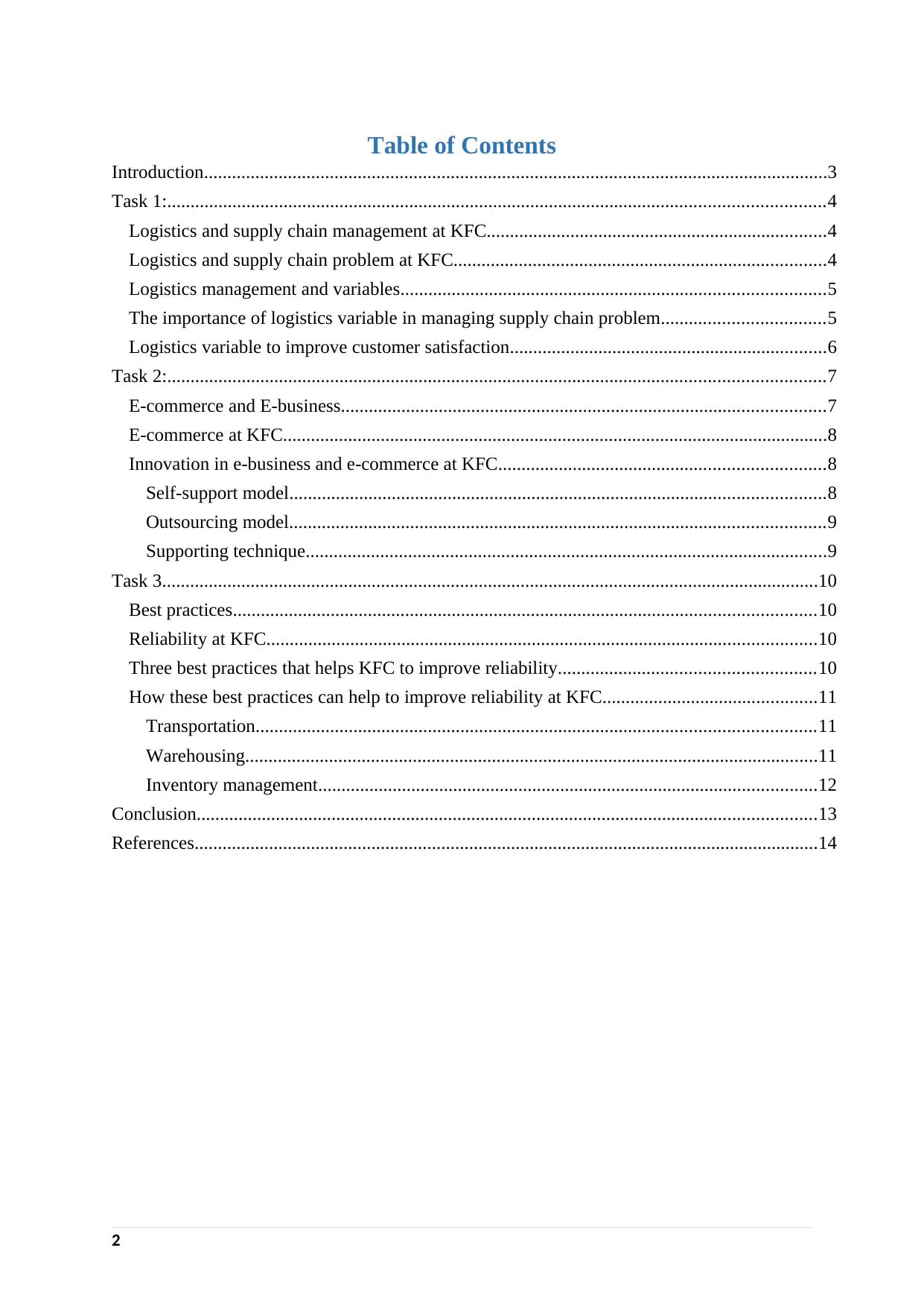
Table of Contents
Introduction......................................................................................................................................3
Task 1:.............................................................................................................................................4
Logistics and supply chain management at KFC.........................................................................4
Logistics and supply chain problem at KFC................................................................................4
Logistics management and variables...........................................................................................5
The importance of logistics variable in managing supply chain problem...................................5
Logistics variable to improve customer satisfaction....................................................................6
Task 2:.............................................................................................................................................7
E-commerce and E-business........................................................................................................7
E-commerce at KFC.....................................................................................................................8
Innovation in e-business and e-commerce at KFC......................................................................8
Self-support model...................................................................................................................8
Outsourcing model...................................................................................................................9
Supporting technique................................................................................................................9
Task 3.............................................................................................................................................10
Best practices.............................................................................................................................10
Reliability at KFC......................................................................................................................10
Three best practices that helps KFC to improve reliability.......................................................10
How these best practices can help to improve reliability at KFC..............................................11
Transportation........................................................................................................................11
Warehousing...........................................................................................................................11
Inventory management...........................................................................................................12
Conclusion.....................................................................................................................................13
References......................................................................................................................................14
2
Introduction......................................................................................................................................3
Task 1:.............................................................................................................................................4
Logistics and supply chain management at KFC.........................................................................4
Logistics and supply chain problem at KFC................................................................................4
Logistics management and variables...........................................................................................5
The importance of logistics variable in managing supply chain problem...................................5
Logistics variable to improve customer satisfaction....................................................................6
Task 2:.............................................................................................................................................7
E-commerce and E-business........................................................................................................7
E-commerce at KFC.....................................................................................................................8
Innovation in e-business and e-commerce at KFC......................................................................8
Self-support model...................................................................................................................8
Outsourcing model...................................................................................................................9
Supporting technique................................................................................................................9
Task 3.............................................................................................................................................10
Best practices.............................................................................................................................10
Reliability at KFC......................................................................................................................10
Three best practices that helps KFC to improve reliability.......................................................10
How these best practices can help to improve reliability at KFC..............................................11
Transportation........................................................................................................................11
Warehousing...........................................................................................................................11
Inventory management...........................................................................................................12
Conclusion.....................................................................................................................................13
References......................................................................................................................................14
2

Introduction
The restaurant giant, KFC has recently undergone a bitter experience from their customers
due to running out of its chicken. This incident has brought complain against the overall
logistics and supply chain management of KFC. These observations highlight the key
importance of the study, as it strives to critically apprise and analyze the logistics and supply
chain management framework of KFC. The current study will be classified into three task.
The task one will analyze the logistics and supply chain management at KFC, logistics and
supply chain problem at KFC, logistics variables and the importance of logistics variables in
managing supply chain problem at KFC. Further, it will evaluate how these logistics
variables improve customer’s satisfaction. The Task two will describe the e-commerce and e-
business, E-commerce at KFC, and e-commerce innovation at KFC and how these innovation
help KFC avoid delays in future. Finally, the study will shed light on assessing best practices,
reliability at KFC. Based on the assessment, it will suggest three best practices that can help
KFC to improve reliability. How these best practices can help KFC to improve reliability will
be justified here.
3
The restaurant giant, KFC has recently undergone a bitter experience from their customers
due to running out of its chicken. This incident has brought complain against the overall
logistics and supply chain management of KFC. These observations highlight the key
importance of the study, as it strives to critically apprise and analyze the logistics and supply
chain management framework of KFC. The current study will be classified into three task.
The task one will analyze the logistics and supply chain management at KFC, logistics and
supply chain problem at KFC, logistics variables and the importance of logistics variables in
managing supply chain problem at KFC. Further, it will evaluate how these logistics
variables improve customer’s satisfaction. The Task two will describe the e-commerce and e-
business, E-commerce at KFC, and e-commerce innovation at KFC and how these innovation
help KFC avoid delays in future. Finally, the study will shed light on assessing best practices,
reliability at KFC. Based on the assessment, it will suggest three best practices that can help
KFC to improve reliability. How these best practices can help KFC to improve reliability will
be justified here.
3
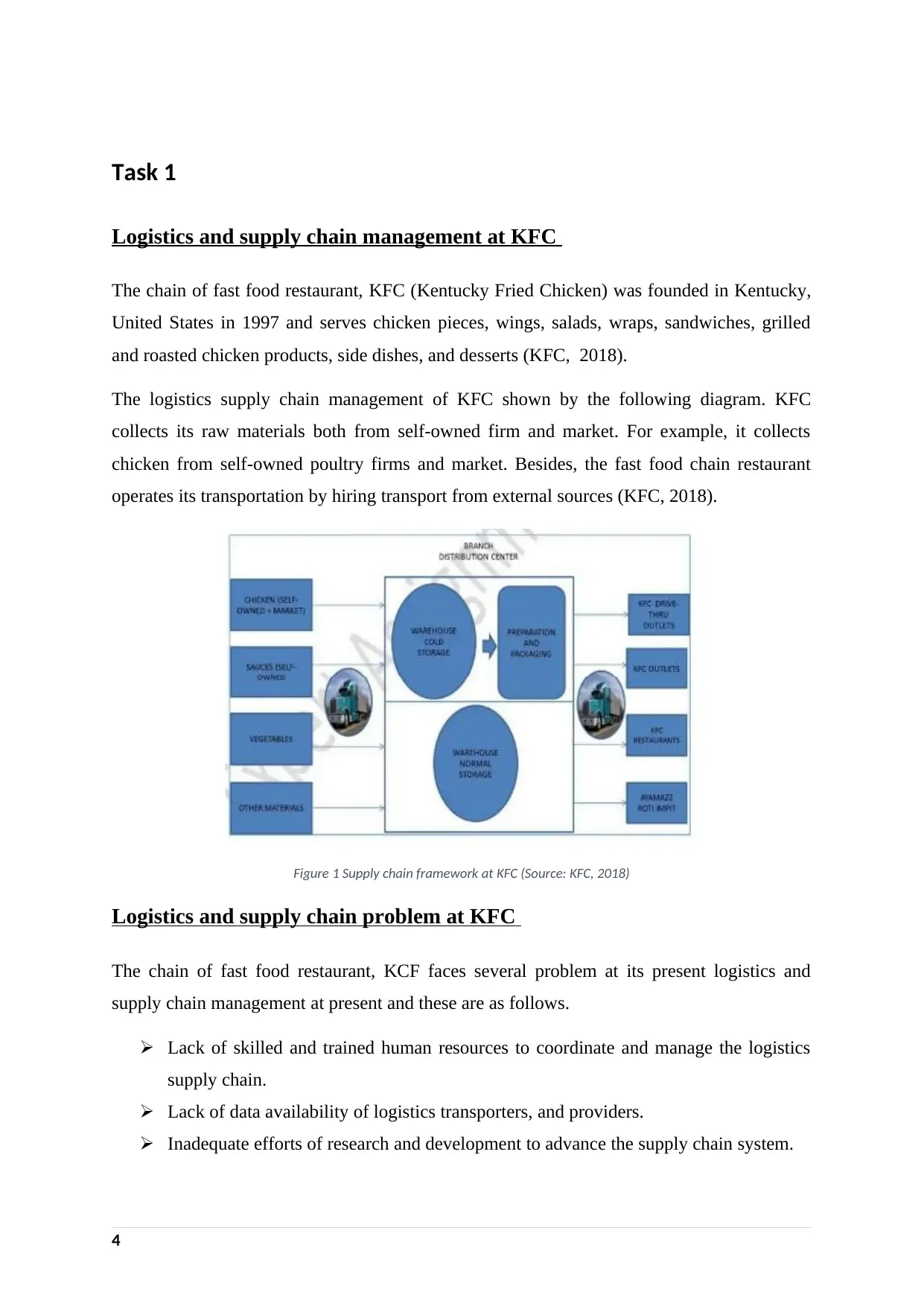
Task 1
Logistics and supply chain management at KFC
The chain of fast food restaurant, KFC (Kentucky Fried Chicken) was founded in Kentucky,
United States in 1997 and serves chicken pieces, wings, salads, wraps, sandwiches, grilled
and roasted chicken products, side dishes, and desserts (KFC, 2018).
The logistics supply chain management of KFC shown by the following diagram. KFC
collects its raw materials both from self-owned firm and market. For example, it collects
chicken from self-owned poultry firms and market. Besides, the fast food chain restaurant
operates its transportation by hiring transport from external sources (KFC, 2018).
Figure 1 Supply chain framework at KFC (Source: KFC, 2018)
Logistics and supply chain problem at KFC
The chain of fast food restaurant, KCF faces several problem at its present logistics and
supply chain management at present and these are as follows.
Lack of skilled and trained human resources to coordinate and manage the logistics
supply chain.
Lack of data availability of logistics transporters, and providers.
Inadequate efforts of research and development to advance the supply chain system.
4
Logistics and supply chain management at KFC
The chain of fast food restaurant, KFC (Kentucky Fried Chicken) was founded in Kentucky,
United States in 1997 and serves chicken pieces, wings, salads, wraps, sandwiches, grilled
and roasted chicken products, side dishes, and desserts (KFC, 2018).
The logistics supply chain management of KFC shown by the following diagram. KFC
collects its raw materials both from self-owned firm and market. For example, it collects
chicken from self-owned poultry firms and market. Besides, the fast food chain restaurant
operates its transportation by hiring transport from external sources (KFC, 2018).
Figure 1 Supply chain framework at KFC (Source: KFC, 2018)
Logistics and supply chain problem at KFC
The chain of fast food restaurant, KCF faces several problem at its present logistics and
supply chain management at present and these are as follows.
Lack of skilled and trained human resources to coordinate and manage the logistics
supply chain.
Lack of data availability of logistics transporters, and providers.
Inadequate efforts of research and development to advance the supply chain system.
4
Secure Best Marks with AI Grader
Need help grading? Try our AI Grader for instant feedback on your assignments.
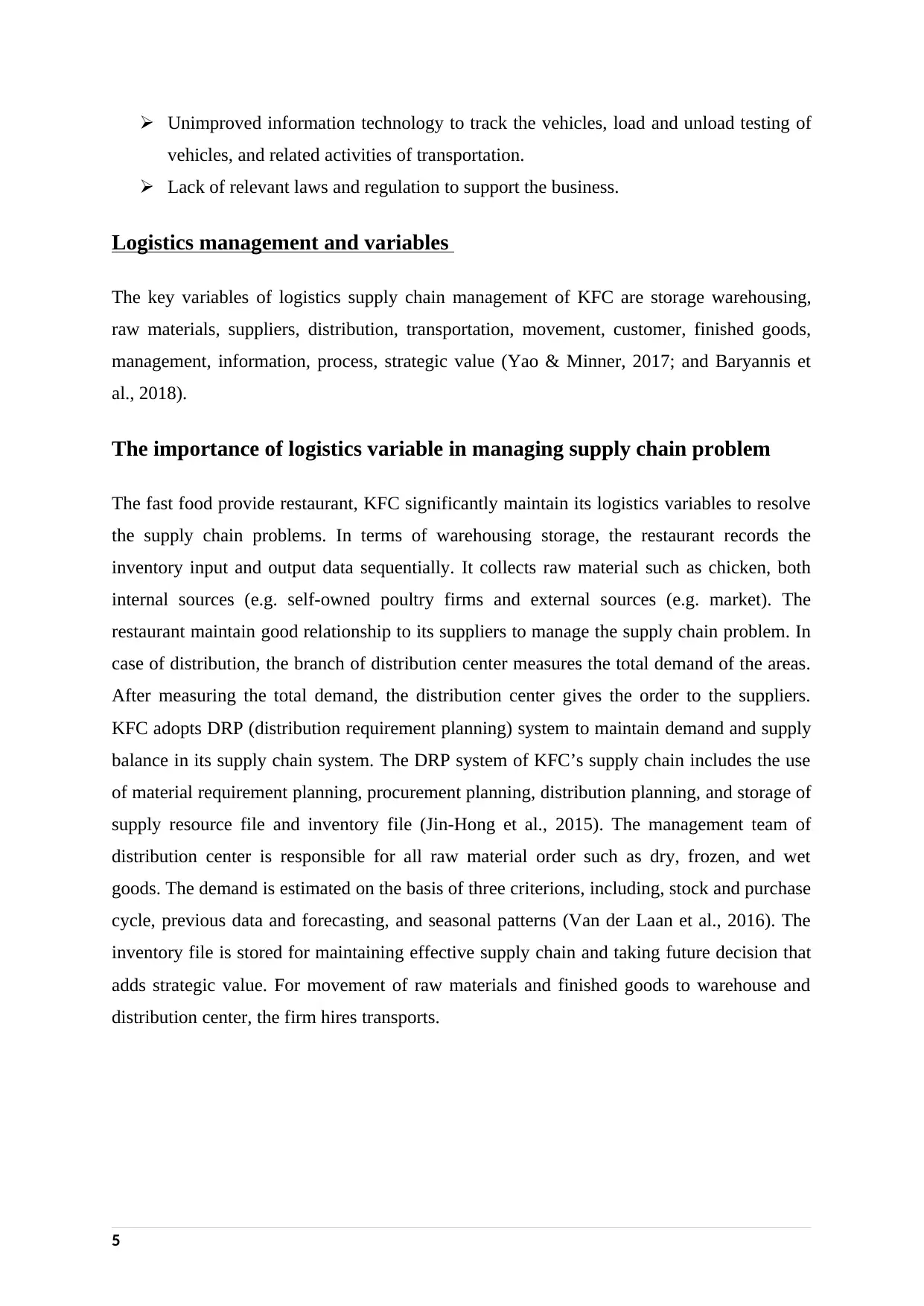
Unimproved information technology to track the vehicles, load and unload testing of
vehicles, and related activities of transportation.
Lack of relevant laws and regulation to support the business.
Logistics management and variables
The key variables of logistics supply chain management of KFC are storage warehousing,
raw materials, suppliers, distribution, transportation, movement, customer, finished goods,
management, information, process, strategic value (Yao & Minner, 2017; and Baryannis et
al., 2018).
The importance of logistics variable in managing supply chain problem
The fast food provide restaurant, KFC significantly maintain its logistics variables to resolve
the supply chain problems. In terms of warehousing storage, the restaurant records the
inventory input and output data sequentially. It collects raw material such as chicken, both
internal sources (e.g. self-owned poultry firms and external sources (e.g. market). The
restaurant maintain good relationship to its suppliers to manage the supply chain problem. In
case of distribution, the branch of distribution center measures the total demand of the areas.
After measuring the total demand, the distribution center gives the order to the suppliers.
KFC adopts DRP (distribution requirement planning) system to maintain demand and supply
balance in its supply chain system. The DRP system of KFC’s supply chain includes the use
of material requirement planning, procurement planning, distribution planning, and storage of
supply resource file and inventory file (Jin-Hong et al., 2015). The management team of
distribution center is responsible for all raw material order such as dry, frozen, and wet
goods. The demand is estimated on the basis of three criterions, including, stock and purchase
cycle, previous data and forecasting, and seasonal patterns (Van der Laan et al., 2016). The
inventory file is stored for maintaining effective supply chain and taking future decision that
adds strategic value. For movement of raw materials and finished goods to warehouse and
distribution center, the firm hires transports.
5
vehicles, and related activities of transportation.
Lack of relevant laws and regulation to support the business.
Logistics management and variables
The key variables of logistics supply chain management of KFC are storage warehousing,
raw materials, suppliers, distribution, transportation, movement, customer, finished goods,
management, information, process, strategic value (Yao & Minner, 2017; and Baryannis et
al., 2018).
The importance of logistics variable in managing supply chain problem
The fast food provide restaurant, KFC significantly maintain its logistics variables to resolve
the supply chain problems. In terms of warehousing storage, the restaurant records the
inventory input and output data sequentially. It collects raw material such as chicken, both
internal sources (e.g. self-owned poultry firms and external sources (e.g. market). The
restaurant maintain good relationship to its suppliers to manage the supply chain problem. In
case of distribution, the branch of distribution center measures the total demand of the areas.
After measuring the total demand, the distribution center gives the order to the suppliers.
KFC adopts DRP (distribution requirement planning) system to maintain demand and supply
balance in its supply chain system. The DRP system of KFC’s supply chain includes the use
of material requirement planning, procurement planning, distribution planning, and storage of
supply resource file and inventory file (Jin-Hong et al., 2015). The management team of
distribution center is responsible for all raw material order such as dry, frozen, and wet
goods. The demand is estimated on the basis of three criterions, including, stock and purchase
cycle, previous data and forecasting, and seasonal patterns (Van der Laan et al., 2016). The
inventory file is stored for maintaining effective supply chain and taking future decision that
adds strategic value. For movement of raw materials and finished goods to warehouse and
distribution center, the firm hires transports.
5

Logistics variable to improve customer satisfaction
KFC always tries to improve customer relationship that enables the firm to satisfy their
customers, and therefore, it significantly maintains the logistics variables in their supply
chain management. The restaurant aim to serve their busy customer quickly but maintaining
good quality and test (KFC, 2018). The logistics variables such as distribution system and
demand forecasting allow the restaurant to serve their customers quickly without shortage of
raw material such as chicken. Through the efficient vehicle and transportation selection, the
KFC would be able to deliver materials quickly to its restaurant. Van deer Laan et al., (2016)
agree that fast and efficient service improve customer satisfaction, and loyalty. In addition,
good inventory management, warehousing, e-logistics, outsourcing, procurement, and
transportation would enable the company to improve and maximize customer satisfaction.
6
KFC always tries to improve customer relationship that enables the firm to satisfy their
customers, and therefore, it significantly maintains the logistics variables in their supply
chain management. The restaurant aim to serve their busy customer quickly but maintaining
good quality and test (KFC, 2018). The logistics variables such as distribution system and
demand forecasting allow the restaurant to serve their customers quickly without shortage of
raw material such as chicken. Through the efficient vehicle and transportation selection, the
KFC would be able to deliver materials quickly to its restaurant. Van deer Laan et al., (2016)
agree that fast and efficient service improve customer satisfaction, and loyalty. In addition,
good inventory management, warehousing, e-logistics, outsourcing, procurement, and
transportation would enable the company to improve and maximize customer satisfaction.
6
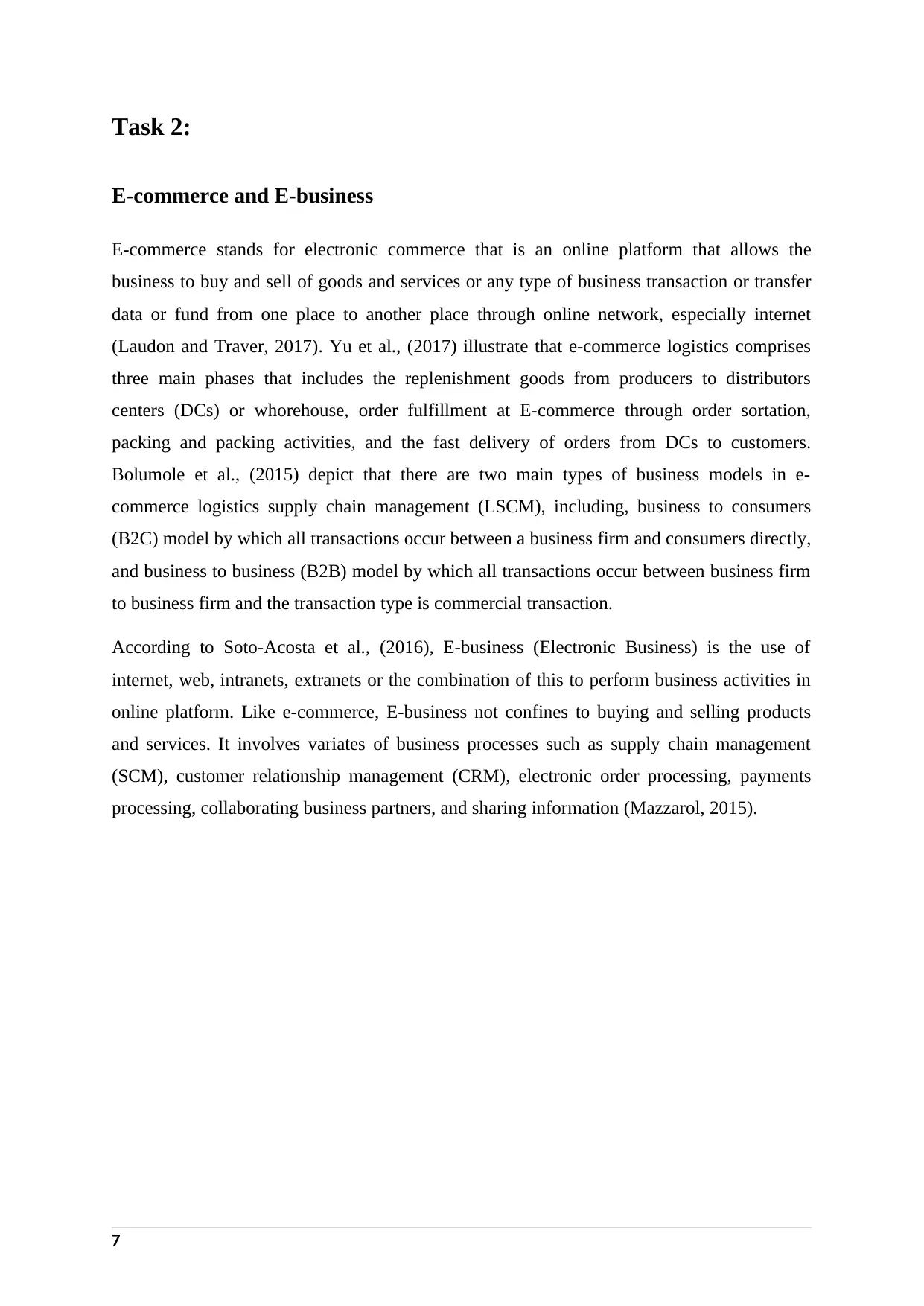
Task 2:
E-commerce and E-business
E-commerce stands for electronic commerce that is an online platform that allows the
business to buy and sell of goods and services or any type of business transaction or transfer
data or fund from one place to another place through online network, especially internet
(Laudon and Traver, 2017). Yu et al., (2017) illustrate that e-commerce logistics comprises
three main phases that includes the replenishment goods from producers to distributors
centers (DCs) or whorehouse, order fulfillment at E-commerce through order sortation,
packing and packing activities, and the fast delivery of orders from DCs to customers.
Bolumole et al., (2015) depict that there are two main types of business models in e-
commerce logistics supply chain management (LSCM), including, business to consumers
(B2C) model by which all transactions occur between a business firm and consumers directly,
and business to business (B2B) model by which all transactions occur between business firm
to business firm and the transaction type is commercial transaction.
According to Soto-Acosta et al., (2016), E-business (Electronic Business) is the use of
internet, web, intranets, extranets or the combination of this to perform business activities in
online platform. Like e-commerce, E-business not confines to buying and selling products
and services. It involves variates of business processes such as supply chain management
(SCM), customer relationship management (CRM), electronic order processing, payments
processing, collaborating business partners, and sharing information (Mazzarol, 2015).
7
E-commerce and E-business
E-commerce stands for electronic commerce that is an online platform that allows the
business to buy and sell of goods and services or any type of business transaction or transfer
data or fund from one place to another place through online network, especially internet
(Laudon and Traver, 2017). Yu et al., (2017) illustrate that e-commerce logistics comprises
three main phases that includes the replenishment goods from producers to distributors
centers (DCs) or whorehouse, order fulfillment at E-commerce through order sortation,
packing and packing activities, and the fast delivery of orders from DCs to customers.
Bolumole et al., (2015) depict that there are two main types of business models in e-
commerce logistics supply chain management (LSCM), including, business to consumers
(B2C) model by which all transactions occur between a business firm and consumers directly,
and business to business (B2B) model by which all transactions occur between business firm
to business firm and the transaction type is commercial transaction.
According to Soto-Acosta et al., (2016), E-business (Electronic Business) is the use of
internet, web, intranets, extranets or the combination of this to perform business activities in
online platform. Like e-commerce, E-business not confines to buying and selling products
and services. It involves variates of business processes such as supply chain management
(SCM), customer relationship management (CRM), electronic order processing, payments
processing, collaborating business partners, and sharing information (Mazzarol, 2015).
7
Paraphrase This Document
Need a fresh take? Get an instant paraphrase of this document with our AI Paraphraser
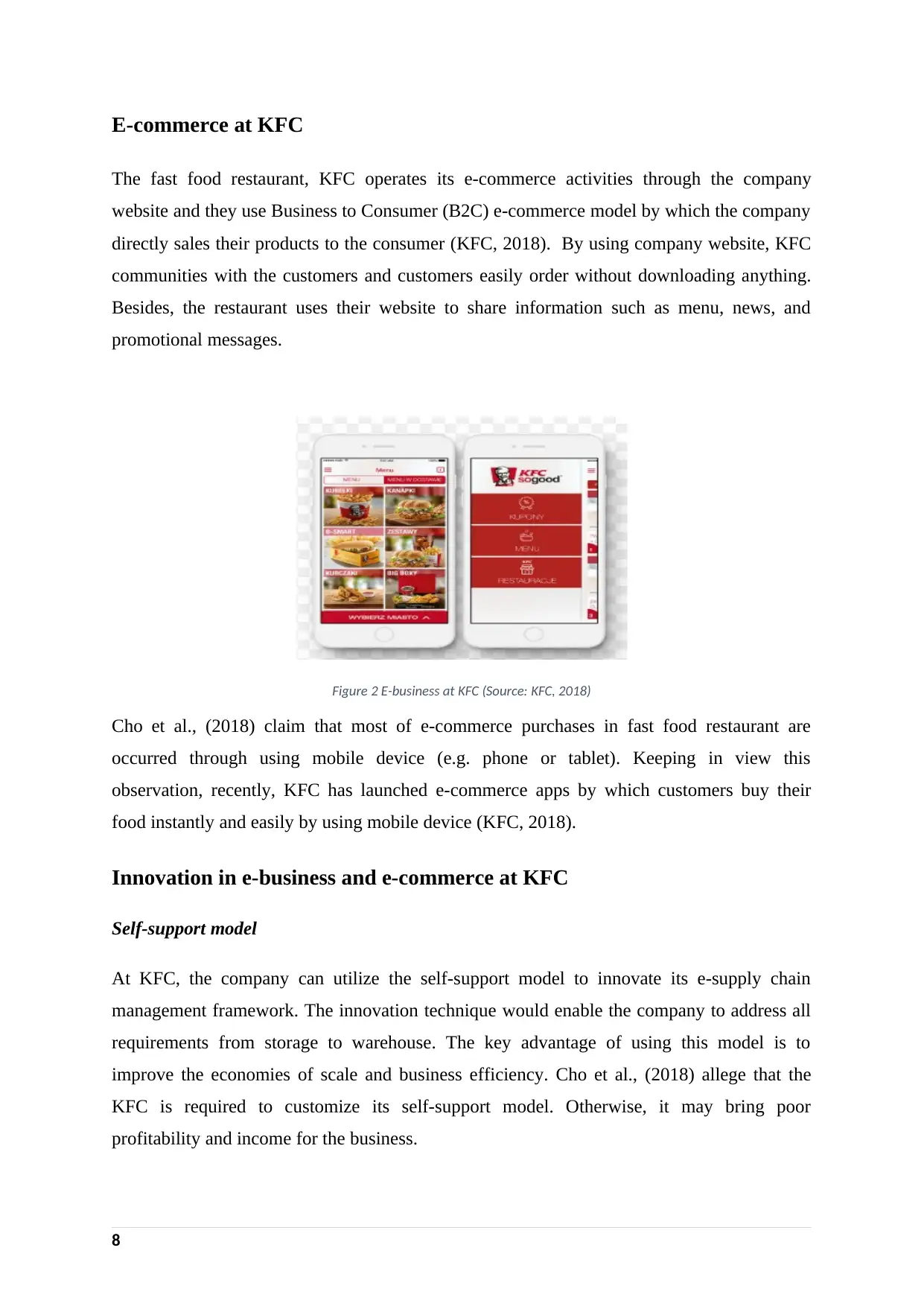
E-commerce at KFC
The fast food restaurant, KFC operates its e-commerce activities through the company
website and they use Business to Consumer (B2C) e-commerce model by which the company
directly sales their products to the consumer (KFC, 2018). By using company website, KFC
communities with the customers and customers easily order without downloading anything.
Besides, the restaurant uses their website to share information such as menu, news, and
promotional messages.
Figure 2 E-business at KFC (Source: KFC, 2018)
Cho et al., (2018) claim that most of e-commerce purchases in fast food restaurant are
occurred through using mobile device (e.g. phone or tablet). Keeping in view this
observation, recently, KFC has launched e-commerce apps by which customers buy their
food instantly and easily by using mobile device (KFC, 2018).
Innovation in e-business and e-commerce at KFC
Self-support model
At KFC, the company can utilize the self-support model to innovate its e-supply chain
management framework. The innovation technique would enable the company to address all
requirements from storage to warehouse. The key advantage of using this model is to
improve the economies of scale and business efficiency. Cho et al., (2018) allege that the
KFC is required to customize its self-support model. Otherwise, it may bring poor
profitability and income for the business.
8
The fast food restaurant, KFC operates its e-commerce activities through the company
website and they use Business to Consumer (B2C) e-commerce model by which the company
directly sales their products to the consumer (KFC, 2018). By using company website, KFC
communities with the customers and customers easily order without downloading anything.
Besides, the restaurant uses their website to share information such as menu, news, and
promotional messages.
Figure 2 E-business at KFC (Source: KFC, 2018)
Cho et al., (2018) claim that most of e-commerce purchases in fast food restaurant are
occurred through using mobile device (e.g. phone or tablet). Keeping in view this
observation, recently, KFC has launched e-commerce apps by which customers buy their
food instantly and easily by using mobile device (KFC, 2018).
Innovation in e-business and e-commerce at KFC
Self-support model
At KFC, the company can utilize the self-support model to innovate its e-supply chain
management framework. The innovation technique would enable the company to address all
requirements from storage to warehouse. The key advantage of using this model is to
improve the economies of scale and business efficiency. Cho et al., (2018) allege that the
KFC is required to customize its self-support model. Otherwise, it may bring poor
profitability and income for the business.
8
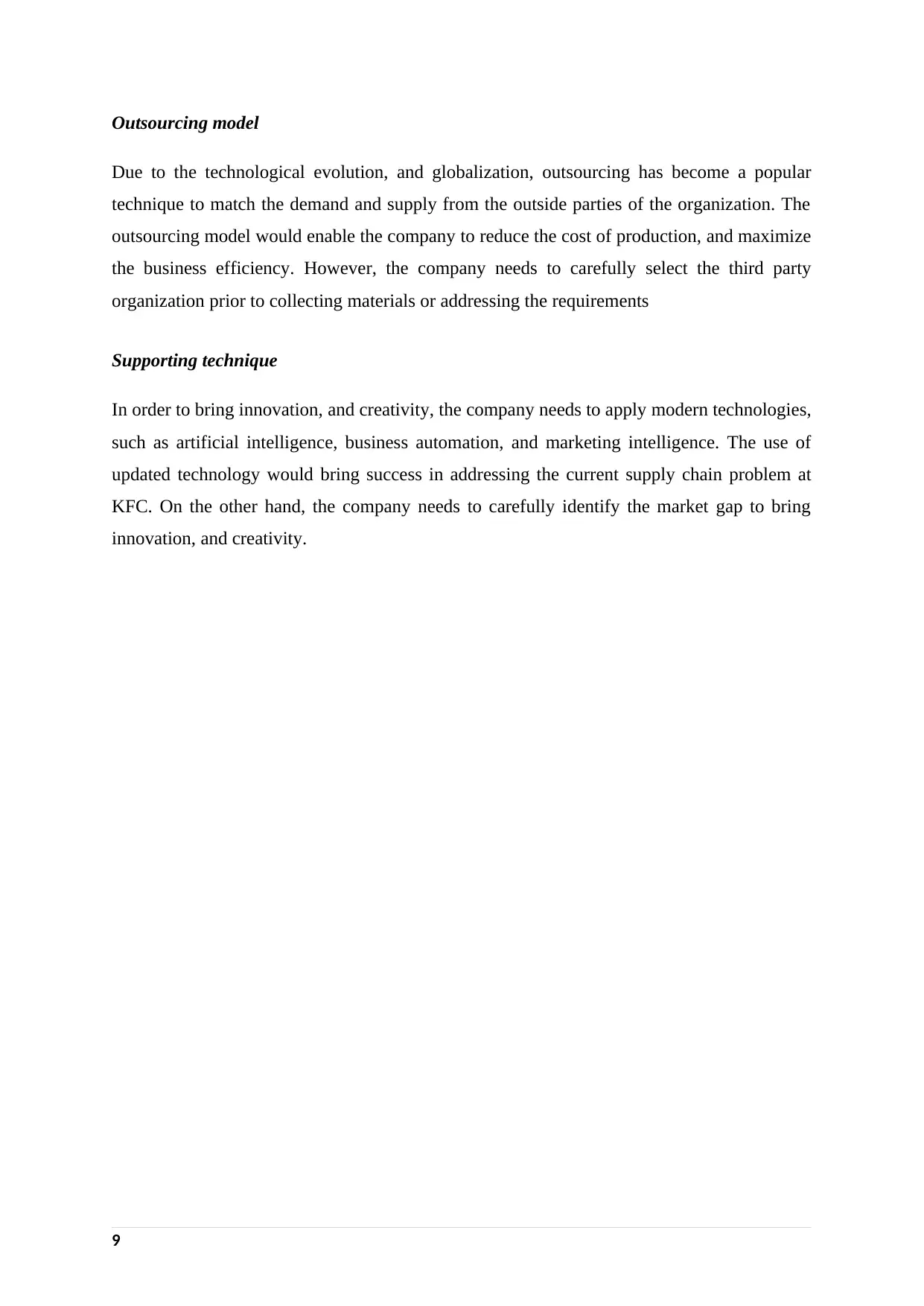
Outsourcing model
Due to the technological evolution, and globalization, outsourcing has become a popular
technique to match the demand and supply from the outside parties of the organization. The
outsourcing model would enable the company to reduce the cost of production, and maximize
the business efficiency. However, the company needs to carefully select the third party
organization prior to collecting materials or addressing the requirements
Supporting technique
In order to bring innovation, and creativity, the company needs to apply modern technologies,
such as artificial intelligence, business automation, and marketing intelligence. The use of
updated technology would bring success in addressing the current supply chain problem at
KFC. On the other hand, the company needs to carefully identify the market gap to bring
innovation, and creativity.
9
Due to the technological evolution, and globalization, outsourcing has become a popular
technique to match the demand and supply from the outside parties of the organization. The
outsourcing model would enable the company to reduce the cost of production, and maximize
the business efficiency. However, the company needs to carefully select the third party
organization prior to collecting materials or addressing the requirements
Supporting technique
In order to bring innovation, and creativity, the company needs to apply modern technologies,
such as artificial intelligence, business automation, and marketing intelligence. The use of
updated technology would bring success in addressing the current supply chain problem at
KFC. On the other hand, the company needs to carefully identify the market gap to bring
innovation, and creativity.
9
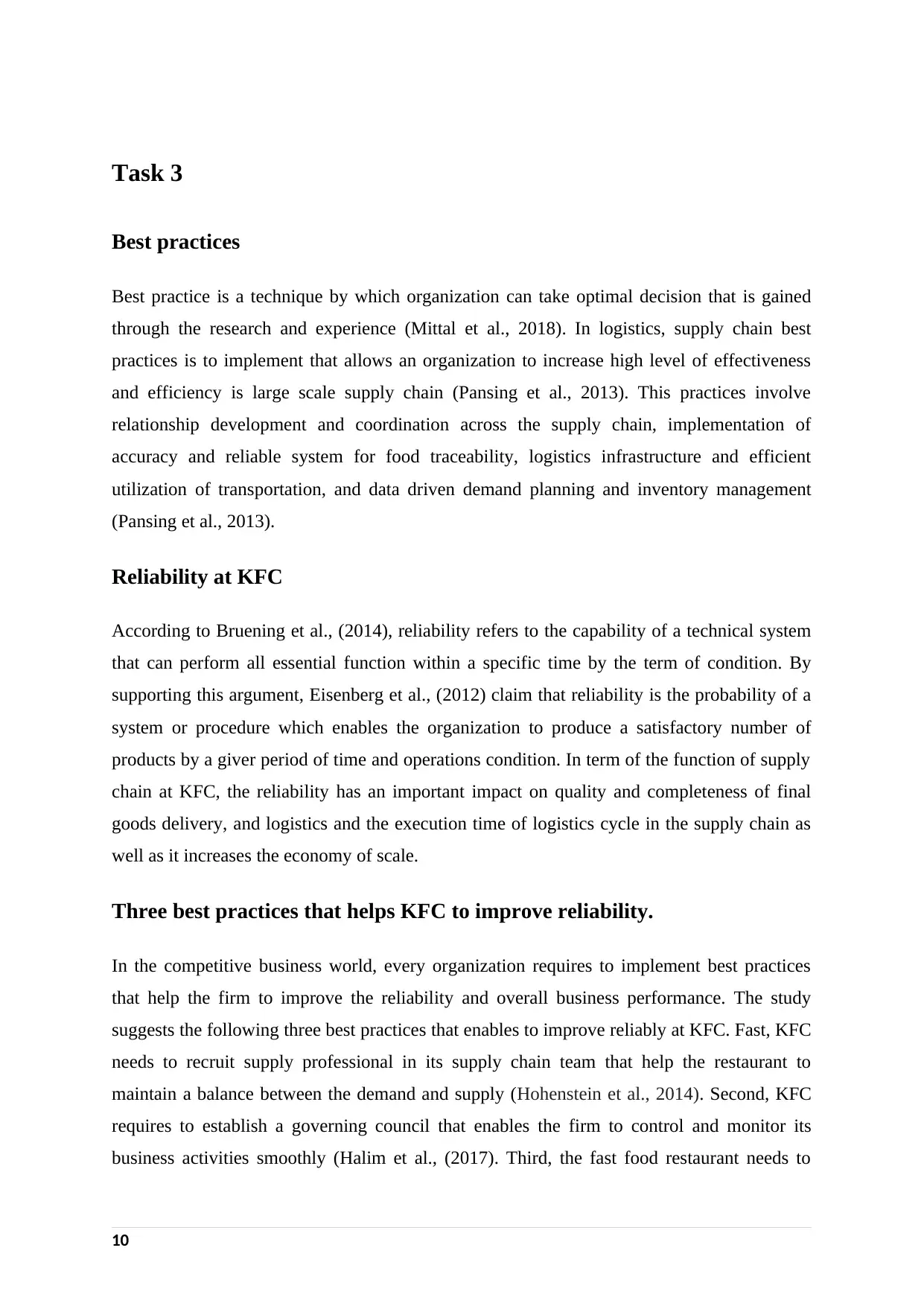
Task 3
Best practices
Best practice is a technique by which organization can take optimal decision that is gained
through the research and experience (Mittal et al., 2018). In logistics, supply chain best
practices is to implement that allows an organization to increase high level of effectiveness
and efficiency is large scale supply chain (Pansing et al., 2013). This practices involve
relationship development and coordination across the supply chain, implementation of
accuracy and reliable system for food traceability, logistics infrastructure and efficient
utilization of transportation, and data driven demand planning and inventory management
(Pansing et al., 2013).
Reliability at KFC
According to Bruening et al., (2014), reliability refers to the capability of a technical system
that can perform all essential function within a specific time by the term of condition. By
supporting this argument, Eisenberg et al., (2012) claim that reliability is the probability of a
system or procedure which enables the organization to produce a satisfactory number of
products by a giver period of time and operations condition. In term of the function of supply
chain at KFC, the reliability has an important impact on quality and completeness of final
goods delivery, and logistics and the execution time of logistics cycle in the supply chain as
well as it increases the economy of scale.
Three best practices that helps KFC to improve reliability.
In the competitive business world, every organization requires to implement best practices
that help the firm to improve the reliability and overall business performance. The study
suggests the following three best practices that enables to improve reliably at KFC. Fast, KFC
needs to recruit supply professional in its supply chain team that help the restaurant to
maintain a balance between the demand and supply (Hohenstein et al., 2014). Second, KFC
requires to establish a governing council that enables the firm to control and monitor its
business activities smoothly (Halim et al., (2017). Third, the fast food restaurant needs to
10
Best practices
Best practice is a technique by which organization can take optimal decision that is gained
through the research and experience (Mittal et al., 2018). In logistics, supply chain best
practices is to implement that allows an organization to increase high level of effectiveness
and efficiency is large scale supply chain (Pansing et al., 2013). This practices involve
relationship development and coordination across the supply chain, implementation of
accuracy and reliable system for food traceability, logistics infrastructure and efficient
utilization of transportation, and data driven demand planning and inventory management
(Pansing et al., 2013).
Reliability at KFC
According to Bruening et al., (2014), reliability refers to the capability of a technical system
that can perform all essential function within a specific time by the term of condition. By
supporting this argument, Eisenberg et al., (2012) claim that reliability is the probability of a
system or procedure which enables the organization to produce a satisfactory number of
products by a giver period of time and operations condition. In term of the function of supply
chain at KFC, the reliability has an important impact on quality and completeness of final
goods delivery, and logistics and the execution time of logistics cycle in the supply chain as
well as it increases the economy of scale.
Three best practices that helps KFC to improve reliability.
In the competitive business world, every organization requires to implement best practices
that help the firm to improve the reliability and overall business performance. The study
suggests the following three best practices that enables to improve reliably at KFC. Fast, KFC
needs to recruit supply professional in its supply chain team that help the restaurant to
maintain a balance between the demand and supply (Hohenstein et al., 2014). Second, KFC
requires to establish a governing council that enables the firm to control and monitor its
business activities smoothly (Halim et al., (2017). Third, the fast food restaurant needs to
10
Secure Best Marks with AI Grader
Need help grading? Try our AI Grader for instant feedback on your assignments.

establish good relationship with its supplier that allows the firm to collect quality raw
materials at reasonable price as per their demand (Emmett & Hohenstein, 2014).
How these best practices can help to improve reliability at KFC
In this section the study describes how the aforementioned three best practices that can help
to improve reliability at KFC. These include recruiting supply chain professional (Hohenstein
et al., 2014), establishing a governing council (Halim et al., (2017), and establishing key
supplier relation (Emmett & Hohenstein, 2014).
Recruiting supply chain professional
The present supply chain of KFC does not address the requirement (KFC, 2018), and
therefore, KFC require to recruit skilled and innovative people in its supply chain team, who
assist the firm to develop new strategy and policy in line with the existent supply chain
(Hohenstein et al., 2014; Cottrill, 2010). To do this, the firm needs to recruit people from the
UK reputed University students, who are business, tourism and hospitality management,
marketing, supply chain and other reputed background. Though it increase cost of KFC, the
newly required people help to new strategy and policy that allows the restaurant to improve
the reliability, while at the same time it helps to increase the sale volume and profitability.
Establishing a governing council
Krishna and He (2015) claim that every organization needs to establish a governing council
that helps the firm to run the business smoothly through monitoring and controlling the
business functions of different department. Halim et al., (2017) argue that governing council
plays a vital role to evaluate and monitor the employee’s performance that help the firm to
understand organization position and help to improve reliability, and therefore, organization
requires to establish a governing council. Keeping in view this observation, KFC needs to
build a governing council. This council includes only executive level employees and strategic
level employees.
11
materials at reasonable price as per their demand (Emmett & Hohenstein, 2014).
How these best practices can help to improve reliability at KFC
In this section the study describes how the aforementioned three best practices that can help
to improve reliability at KFC. These include recruiting supply chain professional (Hohenstein
et al., 2014), establishing a governing council (Halim et al., (2017), and establishing key
supplier relation (Emmett & Hohenstein, 2014).
Recruiting supply chain professional
The present supply chain of KFC does not address the requirement (KFC, 2018), and
therefore, KFC require to recruit skilled and innovative people in its supply chain team, who
assist the firm to develop new strategy and policy in line with the existent supply chain
(Hohenstein et al., 2014; Cottrill, 2010). To do this, the firm needs to recruit people from the
UK reputed University students, who are business, tourism and hospitality management,
marketing, supply chain and other reputed background. Though it increase cost of KFC, the
newly required people help to new strategy and policy that allows the restaurant to improve
the reliability, while at the same time it helps to increase the sale volume and profitability.
Establishing a governing council
Krishna and He (2015) claim that every organization needs to establish a governing council
that helps the firm to run the business smoothly through monitoring and controlling the
business functions of different department. Halim et al., (2017) argue that governing council
plays a vital role to evaluate and monitor the employee’s performance that help the firm to
understand organization position and help to improve reliability, and therefore, organization
requires to establish a governing council. Keeping in view this observation, KFC needs to
build a governing council. This council includes only executive level employees and strategic
level employees.
11

Establishing key supplier relation
Sjoerdsma and Van (2015) illustrate that organization require to establish a relationship with
its suppliers, because the suppliers are responsible for supplying raw material. If the suppliers
do not supply the raw material, firm can to address the demand of the customers and
therefore, every organization needs to build a good relationship with the supplier to maintain
demand and supply balance (Emmett & Hohenstein, 2014). DHL and QSL are the key
supplier of KFC, who are responsible to supply required chicken. Besides, KFC can collect
its raw material from other suppliers who are located near the outlet that reduces
transportation cost. However, KFC needs to establish a good relationship with the suppliers
that allows the firm to collect quality raw materials at reasonable price as per their demand
and improve reliability.
12
Sjoerdsma and Van (2015) illustrate that organization require to establish a relationship with
its suppliers, because the suppliers are responsible for supplying raw material. If the suppliers
do not supply the raw material, firm can to address the demand of the customers and
therefore, every organization needs to build a good relationship with the supplier to maintain
demand and supply balance (Emmett & Hohenstein, 2014). DHL and QSL are the key
supplier of KFC, who are responsible to supply required chicken. Besides, KFC can collect
its raw material from other suppliers who are located near the outlet that reduces
transportation cost. However, KFC needs to establish a good relationship with the suppliers
that allows the firm to collect quality raw materials at reasonable price as per their demand
and improve reliability.
12

Conclusion:
The key purpose of the study was to critically appraise the logistics and supply chain
management of KFC in terms of providing best practice model to improve and promote the
logistics and supply chain framework. It has been demonstrated that the current problems of
logistics and supply chain management at KFC directly affects the profitability and income of
the company. This also reduces the reliability. In order to improve and innovate the logistics
and supply chain management framework, the company needs to utilize supporting model,
outsourcing model, transportation, warehousing, and inventory management in a proper way.
13
The key purpose of the study was to critically appraise the logistics and supply chain
management of KFC in terms of providing best practice model to improve and promote the
logistics and supply chain framework. It has been demonstrated that the current problems of
logistics and supply chain management at KFC directly affects the profitability and income of
the company. This also reduces the reliability. In order to improve and innovate the logistics
and supply chain management framework, the company needs to utilize supporting model,
outsourcing model, transportation, warehousing, and inventory management in a proper way.
13
Paraphrase This Document
Need a fresh take? Get an instant paraphrase of this document with our AI Paraphraser

References:
Abatekassa, G., & Peterson, H. C. (2011). Market access for local food through the
conventional food supply chain. International Food and Agribusiness Management
Review, 14(1), 41-60.
Baryannis, G., Validi, S., Dani, S., & Antoniou, G. (2018). Supply chain risk management
and artificial intelligence: state of the art and future research directions. International Journal
of Production Research, 1-24.
Bolumole, Y. A., Closs, D. J., & Rodammer, F. A. (2015). The economic development role
of regional logistics hubs: a cross‐country study of interorganizational governance
models. Journal of Business Logistics, 36(2), 182-198.
Bosona, T. G., & Gebresenbet, G. (2011). Cluster building and logistics network integration
of local food supply chain. Biosystems engineering, 108(4), 293-302.
Bruening, M., MacLehose, R., Eisenberg, M. E., Nanney, M. S., Story, M., & Neumark-
Sztainer, D. (2014). Associations between sugar-sweetened beverage consumption and fast-
food restaurant frequency among adolescents and their friends. Journal of nutrition education
and behavior, 46(4), 277-285.
Cho, M., Bonn, M. A., & Li, J. J. (2018). Differences in perceptions about food delivery apps
between single-person and multi-person households. International Journal of Hospitality
Management.
Clancy, K., & Ruhf, K. (2010). Is local enough? Some arguments for regional food
systems. Choices, 25(1), 123-135.
Cottrill, K. (2010). Are you prepared for the supply chain talent crisis?. MIT Center for
Transportation and Logistics, Cambridge, MA, 1-11.
Eisenberg, M. E., Wall, M., Shim, J. J., Bruening, M., Loth, K., & Neumark-Sztainer, D.
(2012). Associations between friends' disordered eating and muscle-enhancing
behaviors. Social Science & Medicine, 75(12), 2242-2249.
14
Abatekassa, G., & Peterson, H. C. (2011). Market access for local food through the
conventional food supply chain. International Food and Agribusiness Management
Review, 14(1), 41-60.
Baryannis, G., Validi, S., Dani, S., & Antoniou, G. (2018). Supply chain risk management
and artificial intelligence: state of the art and future research directions. International Journal
of Production Research, 1-24.
Bolumole, Y. A., Closs, D. J., & Rodammer, F. A. (2015). The economic development role
of regional logistics hubs: a cross‐country study of interorganizational governance
models. Journal of Business Logistics, 36(2), 182-198.
Bosona, T. G., & Gebresenbet, G. (2011). Cluster building and logistics network integration
of local food supply chain. Biosystems engineering, 108(4), 293-302.
Bruening, M., MacLehose, R., Eisenberg, M. E., Nanney, M. S., Story, M., & Neumark-
Sztainer, D. (2014). Associations between sugar-sweetened beverage consumption and fast-
food restaurant frequency among adolescents and their friends. Journal of nutrition education
and behavior, 46(4), 277-285.
Cho, M., Bonn, M. A., & Li, J. J. (2018). Differences in perceptions about food delivery apps
between single-person and multi-person households. International Journal of Hospitality
Management.
Clancy, K., & Ruhf, K. (2010). Is local enough? Some arguments for regional food
systems. Choices, 25(1), 123-135.
Cottrill, K. (2010). Are you prepared for the supply chain talent crisis?. MIT Center for
Transportation and Logistics, Cambridge, MA, 1-11.
Eisenberg, M. E., Wall, M., Shim, J. J., Bruening, M., Loth, K., & Neumark-Sztainer, D.
(2012). Associations between friends' disordered eating and muscle-enhancing
behaviors. Social Science & Medicine, 75(12), 2242-2249.
14
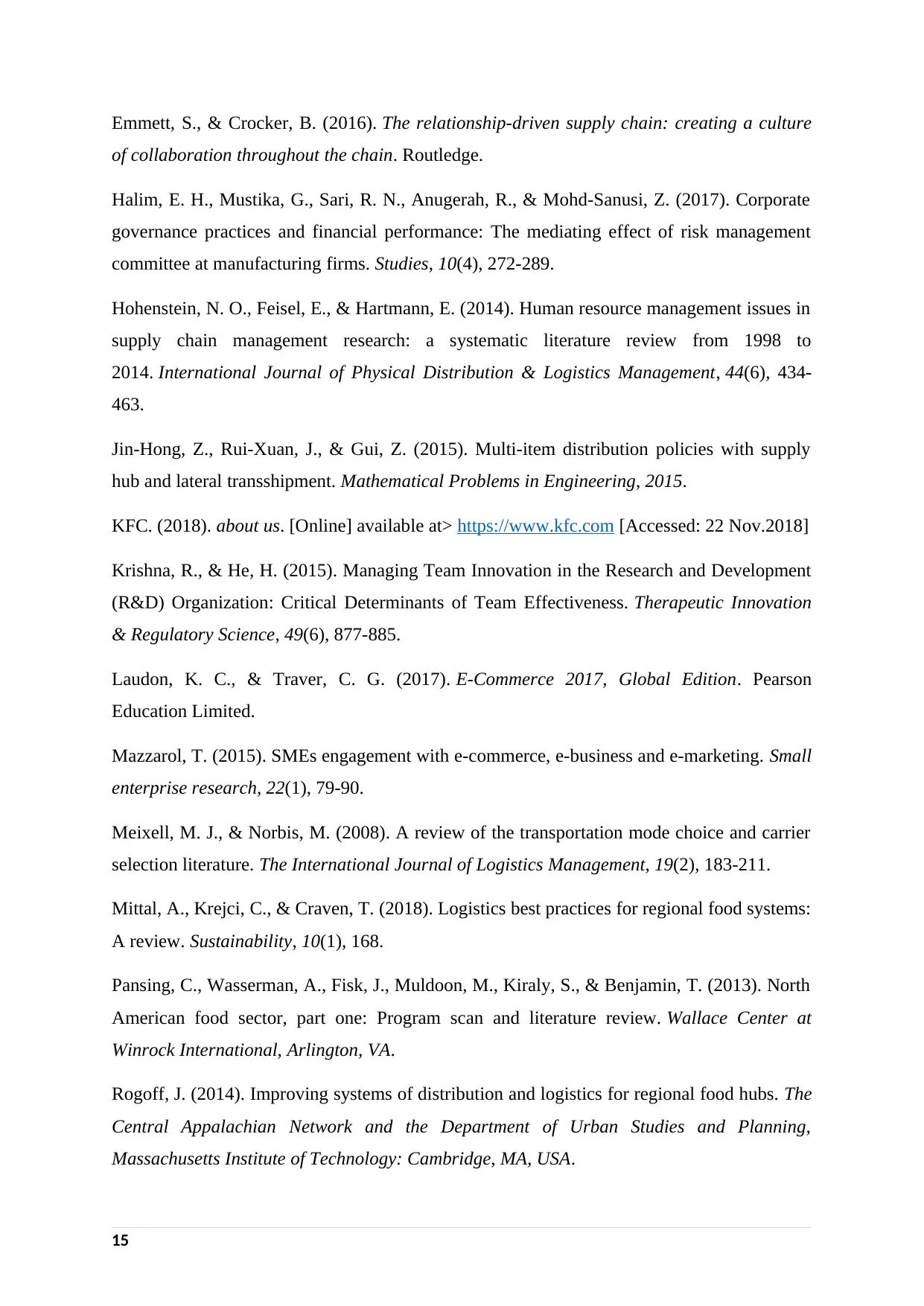
Emmett, S., & Crocker, B. (2016). The relationship-driven supply chain: creating a culture
of collaboration throughout the chain. Routledge.
Halim, E. H., Mustika, G., Sari, R. N., Anugerah, R., & Mohd-Sanusi, Z. (2017). Corporate
governance practices and financial performance: The mediating effect of risk management
committee at manufacturing firms. Studies, 10(4), 272-289.
Hohenstein, N. O., Feisel, E., & Hartmann, E. (2014). Human resource management issues in
supply chain management research: a systematic literature review from 1998 to
2014. International Journal of Physical Distribution & Logistics Management, 44(6), 434-
463.
Jin-Hong, Z., Rui-Xuan, J., & Gui, Z. (2015). Multi-item distribution policies with supply
hub and lateral transshipment. Mathematical Problems in Engineering, 2015.
KFC. (2018). about us. [Online] available at> https://www.kfc.com [Accessed: 22 Nov.2018]
Krishna, R., & He, H. (2015). Managing Team Innovation in the Research and Development
(R&D) Organization: Critical Determinants of Team Effectiveness. Therapeutic Innovation
& Regulatory Science, 49(6), 877-885.
Laudon, K. C., & Traver, C. G. (2017). E-Commerce 2017, Global Edition. Pearson
Education Limited.
Mazzarol, T. (2015). SMEs engagement with e-commerce, e-business and e-marketing. Small
enterprise research, 22(1), 79-90.
Meixell, M. J., & Norbis, M. (2008). A review of the transportation mode choice and carrier
selection literature. The International Journal of Logistics Management, 19(2), 183-211.
Mittal, A., Krejci, C., & Craven, T. (2018). Logistics best practices for regional food systems:
A review. Sustainability, 10(1), 168.
Pansing, C., Wasserman, A., Fisk, J., Muldoon, M., Kiraly, S., & Benjamin, T. (2013). North
American food sector, part one: Program scan and literature review. Wallace Center at
Winrock International, Arlington, VA.
Rogoff, J. (2014). Improving systems of distribution and logistics for regional food hubs. The
Central Appalachian Network and the Department of Urban Studies and Planning,
Massachusetts Institute of Technology: Cambridge, MA, USA.
15
of collaboration throughout the chain. Routledge.
Halim, E. H., Mustika, G., Sari, R. N., Anugerah, R., & Mohd-Sanusi, Z. (2017). Corporate
governance practices and financial performance: The mediating effect of risk management
committee at manufacturing firms. Studies, 10(4), 272-289.
Hohenstein, N. O., Feisel, E., & Hartmann, E. (2014). Human resource management issues in
supply chain management research: a systematic literature review from 1998 to
2014. International Journal of Physical Distribution & Logistics Management, 44(6), 434-
463.
Jin-Hong, Z., Rui-Xuan, J., & Gui, Z. (2015). Multi-item distribution policies with supply
hub and lateral transshipment. Mathematical Problems in Engineering, 2015.
KFC. (2018). about us. [Online] available at> https://www.kfc.com [Accessed: 22 Nov.2018]
Krishna, R., & He, H. (2015). Managing Team Innovation in the Research and Development
(R&D) Organization: Critical Determinants of Team Effectiveness. Therapeutic Innovation
& Regulatory Science, 49(6), 877-885.
Laudon, K. C., & Traver, C. G. (2017). E-Commerce 2017, Global Edition. Pearson
Education Limited.
Mazzarol, T. (2015). SMEs engagement with e-commerce, e-business and e-marketing. Small
enterprise research, 22(1), 79-90.
Meixell, M. J., & Norbis, M. (2008). A review of the transportation mode choice and carrier
selection literature. The International Journal of Logistics Management, 19(2), 183-211.
Mittal, A., Krejci, C., & Craven, T. (2018). Logistics best practices for regional food systems:
A review. Sustainability, 10(1), 168.
Pansing, C., Wasserman, A., Fisk, J., Muldoon, M., Kiraly, S., & Benjamin, T. (2013). North
American food sector, part one: Program scan and literature review. Wallace Center at
Winrock International, Arlington, VA.
Rogoff, J. (2014). Improving systems of distribution and logistics for regional food hubs. The
Central Appalachian Network and the Department of Urban Studies and Planning,
Massachusetts Institute of Technology: Cambridge, MA, USA.
15

Sjoerdsma, M., & van Weele, A. J. (2015). Managing supplier relationships in a new product
development context. Journal of Purchasing and Supply Management, 21(3), 192-203.
Soto-Acosta, P., Popa, S., & Palacios-Marqués, D. (2016). E-business, organizational
innovation and firm performance in manufacturing SMEs: an empirical study in
Spain. Technological and Economic Development of Economy, 22(6), 885-904.
Van der Laan, E., van Dalen, J., Rohrmoser, M., & Simpson, R. (2016). Demand forecasting
and order planning for humanitarian logistics: An empirical assessment. Journal of
Operations Management, 45, 114-122.
Woods, T., Velandia, M., Holcomb, R., Dunning, R., & Bendfeldt, E. (2013). Local food
systems markets and supply chains. Choices, 28(4), 7.
Yao, M., & Minner, S. (2017). Review of multi-supplier inventory models in supply chain
management: An update.
Yu, Y., Wang, X., Zhong, R. Y., & Huang, G. Q. (2017). E-commerce logistics in supply
chain management: Implementations and future perspective in furniture industry. Industrial
Management & Data Systems, 117(10), 2263-2286.
16
development context. Journal of Purchasing and Supply Management, 21(3), 192-203.
Soto-Acosta, P., Popa, S., & Palacios-Marqués, D. (2016). E-business, organizational
innovation and firm performance in manufacturing SMEs: an empirical study in
Spain. Technological and Economic Development of Economy, 22(6), 885-904.
Van der Laan, E., van Dalen, J., Rohrmoser, M., & Simpson, R. (2016). Demand forecasting
and order planning for humanitarian logistics: An empirical assessment. Journal of
Operations Management, 45, 114-122.
Woods, T., Velandia, M., Holcomb, R., Dunning, R., & Bendfeldt, E. (2013). Local food
systems markets and supply chains. Choices, 28(4), 7.
Yao, M., & Minner, S. (2017). Review of multi-supplier inventory models in supply chain
management: An update.
Yu, Y., Wang, X., Zhong, R. Y., & Huang, G. Q. (2017). E-commerce logistics in supply
chain management: Implementations and future perspective in furniture industry. Industrial
Management & Data Systems, 117(10), 2263-2286.
16
1 out of 16
Related Documents
Your All-in-One AI-Powered Toolkit for Academic Success.
+13062052269
info@desklib.com
Available 24*7 on WhatsApp / Email
![[object Object]](/_next/static/media/star-bottom.7253800d.svg)
Unlock your academic potential
© 2024 | Zucol Services PVT LTD | All rights reserved.





